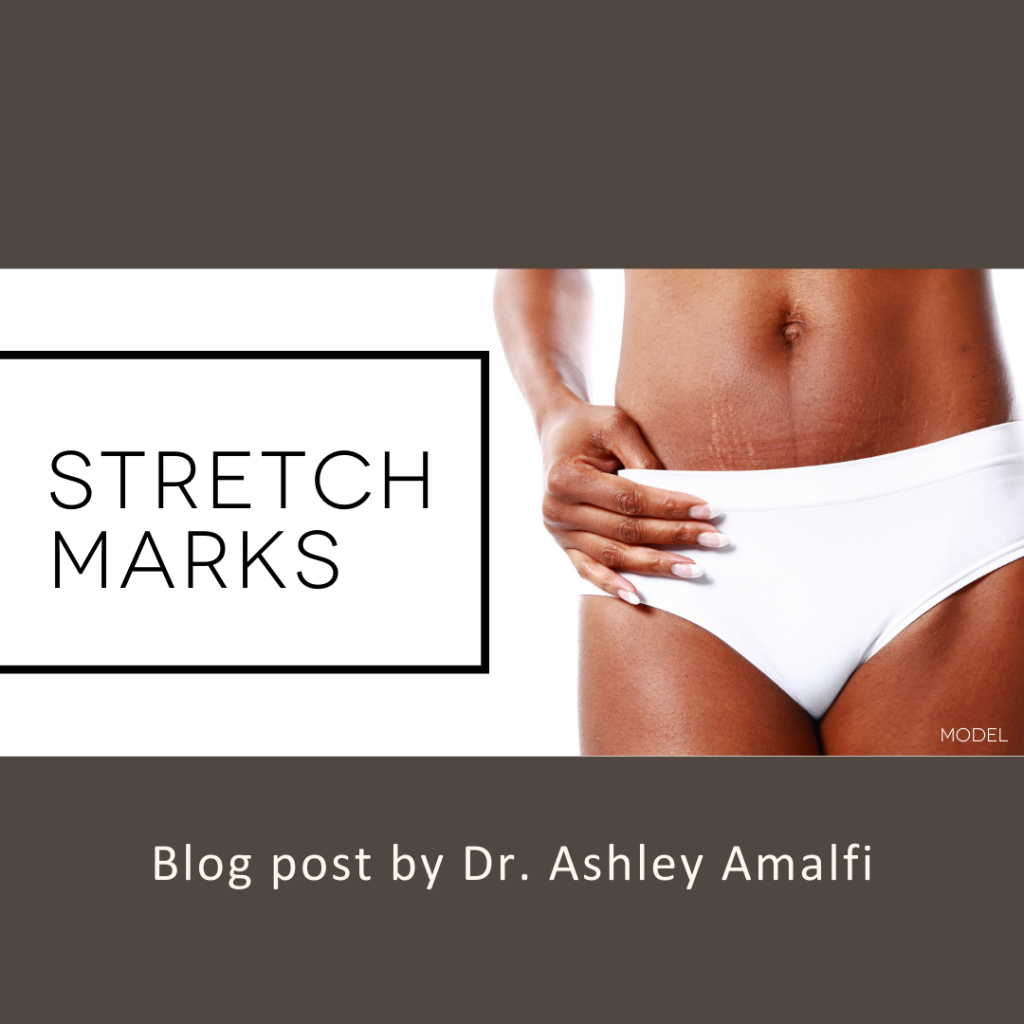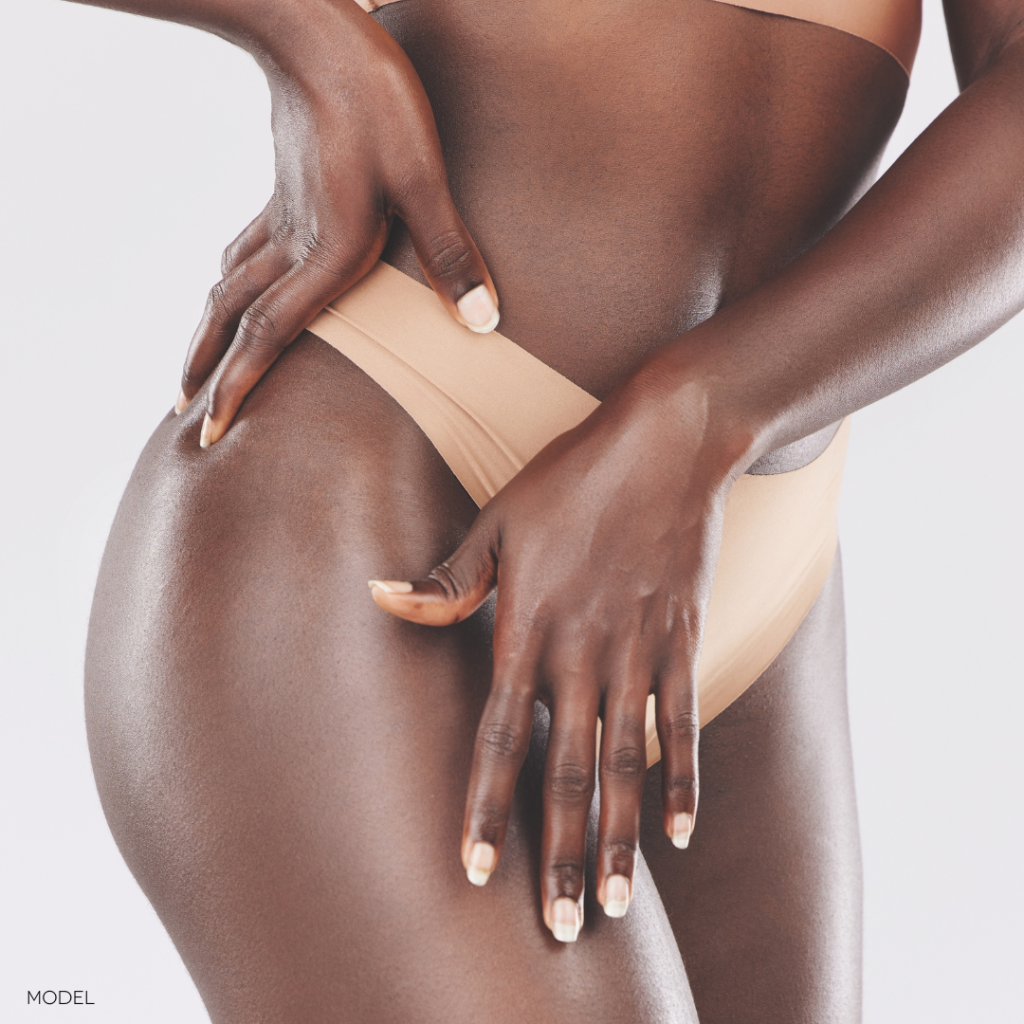-by board-certified plastic surgeon Ashley N. Amalfi, MD
What are stretch marks anyway?
Stretch marks are a type of scar to the skin, sometimes referred to as striae by your doctor. They are caused by a tear in the dermis, or the deeper layer of our skin, often from abrupt stretching of the tissue. This rupture of the collagen and elastin leaves a permanent scar when it heals, and from the surface this develops into a visible stretch mark as we know it.
When they first appear, stretch marks are very dark in color, often purple or red. They can be raised above the skin and slightly puffy and itchy. The good news is that the appearance of stretch marks improves with time. Over a year, the color fades from red to a pale color and the marks flatten or appear slightly depressed below the level of the surrounding skin.
Who is at risk?
Everyone has the capacity to develop stretch marks, but those who are under the extreme fluctuations of hormones (such as pregnant women), or individuals with a family history of stretch marks may be more susceptible. I have heard many women call them their ‘tiger stripes,’ a physical representation of just what their abdomen did to accommodate their growing baby. Outside of pregnancy, many teens develop stretch marks during puberty in response to their growing and changing body. Extreme muscle building and fluctuations in body habits may also cause stretch marks to appear as the body contour changes. The prolonged use of some medications which can thin the skin, like corticosteroids, may also cause stretch marks to appear.
The million dollar question….how can I get rid of them?
Unfortunately, like a scar anywhere else on your body, stretch marks are permanent. But scar massage may help to improve the appearance of your stretch marks if started early in the progression. Applying pressure to your scar or stretch mark may quicken the maturation of your scar and help to improve its appearance. Massage is recommended at least once daily as soon as the stretch mark or scar appears. After one year, the scar is typically fully mature.
If your stretch marks are red in appearance, there is limited research to show that the ingredients Hyaluronic Acid and Tretinoin may have a small benefit in improving the pigment of them. Vascular laser treatments may also improve the redness or pigment changes in your stretch marks. While some of these modalities may help improve their appearance, none of them will make stretch marks go away completely.
Is there anything I can do to prevent stretch marks?
The quick answer to this question is, maybe. Keeping the skin well hydrated and avoiding excessive weight gain may be your only chance to prevent permanent damage to the skin. While research has yet to find the perfect product to prevent stretch marks, controlling changes to our body and weight may be our best bet to keep our skin looking healthy and smooth.
Are there any surgical options?
If your stretch marks are on your lower abdomen after pregnancy, you are in luck. Stretch marks that are below your belly button can be surgically removed in an abdominoplasty, or tummy tuck procedure. This surgery removes the skin below the belly button permanently and uses the upper skin to create a tighter abdomen and a smoother appearance. It is important to meet with a board-certified plastic surgeon to discuss realistic expectations with this type of surgery, and to understand how this type of surgery will remove damaged skin and relocate upper stretch marks to a more hidden location near the bikini line.
For more information, contact our office at (585) 244-1000 or Quatela.com to speak to a Patient Consultant.
References
Hague A and Bayat A. “Therapeutic targets in the management of striae distensae: A systematic review.” J Am Acad Dermatol. 2017;77(3):559-68.
Ud‐Din S, McGeorge D, et al. “Topical management of striae distensae (stretch marks): prevention and therapy of striae rubrae and albae. J Eur Acad Dermatol Venereol. 2016; 30(2): 211–22
Janis J et al. “Evidence-Based Scar Management: How to Improve Results with Technique and Technology.” Plas Recon J. 138(3S):165S-178S, September 2016.




Leave a Reply